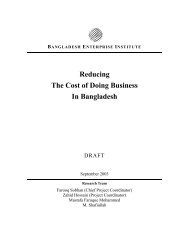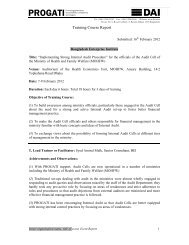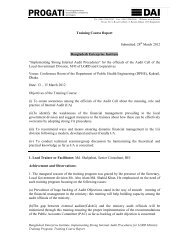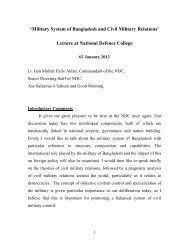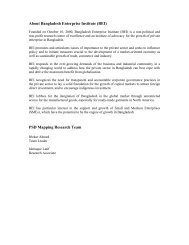Bangladesh Social Enterprise Project - Bangladesh Enterprise Institute
Bangladesh Social Enterprise Project - Bangladesh Enterprise Institute
Bangladesh Social Enterprise Project - Bangladesh Enterprise Institute
Create successful ePaper yourself
Turn your PDF publications into a flip-book with our unique Google optimized e-Paper software.
The publication outlines the basics of <strong>Social</strong> <strong>Enterprise</strong> Zones. In these zones a consortium<br />
of voluntary, public and private agencies team up to crate an “enabling environment” in<br />
areas of “long‐term multiple deprivation”. These zones move a step further away from the<br />
idea of a nanny state and draw on the untapped potential of less fortunate communities.<br />
Talbot, Chris. 2002. ‘<strong>Social</strong> enterprise in Australia: an introductory handbook.’<br />
This handbook was published to attempt to explain the concept of the social enterprise in<br />
relation to current societal needs. It begins by defining social enterprises and examining<br />
exactly why they are necessary. It then looks at the various elements of the social enterprise,<br />
including raising finance, company growth, development, and the different types of social<br />
enterprises. The final part is a business plan which goes into the details about implementing a<br />
social enterprise, including concept and development, marketing, management and production,<br />
financial planning and business structures.<br />
Wilson, C. & Wilson, P. 2006. ‘Make Poverty Business’. Greenleaf Publishing, UK<br />
“Poor people in developing countries could make excellent suppliers, employees and<br />
customers but are often ignored by major businesses. This omission leads to increased risk,<br />
higher costs and lower sales. Meanwhile, businesses are asked by governments and poverty<br />
activists to do more for economic development, but their exhortations are rarely based on a<br />
proper business case. It bridges the gap by constructing a rigorous profit‐making argument<br />
for multinational corporations to do more business with the poor. It takes economic<br />
development out of the corporate social responsibility ghetto and places it firmly in the core<br />
business interests of the corporation, and argues that to see the poor only as potential<br />
consumers misses half of the story. The book should be read by international business<br />
managers seeking to increase profits and decrease risk in developing countries, and by<br />
development advocates who seek to harness the profit motive to reduce poverty. The book<br />
makes numerous low‐risk, low‐cost recommendations for businesses and donors, all of which<br />
are rooted in a rigorous discussion of the underlying strategic and economic issues.






